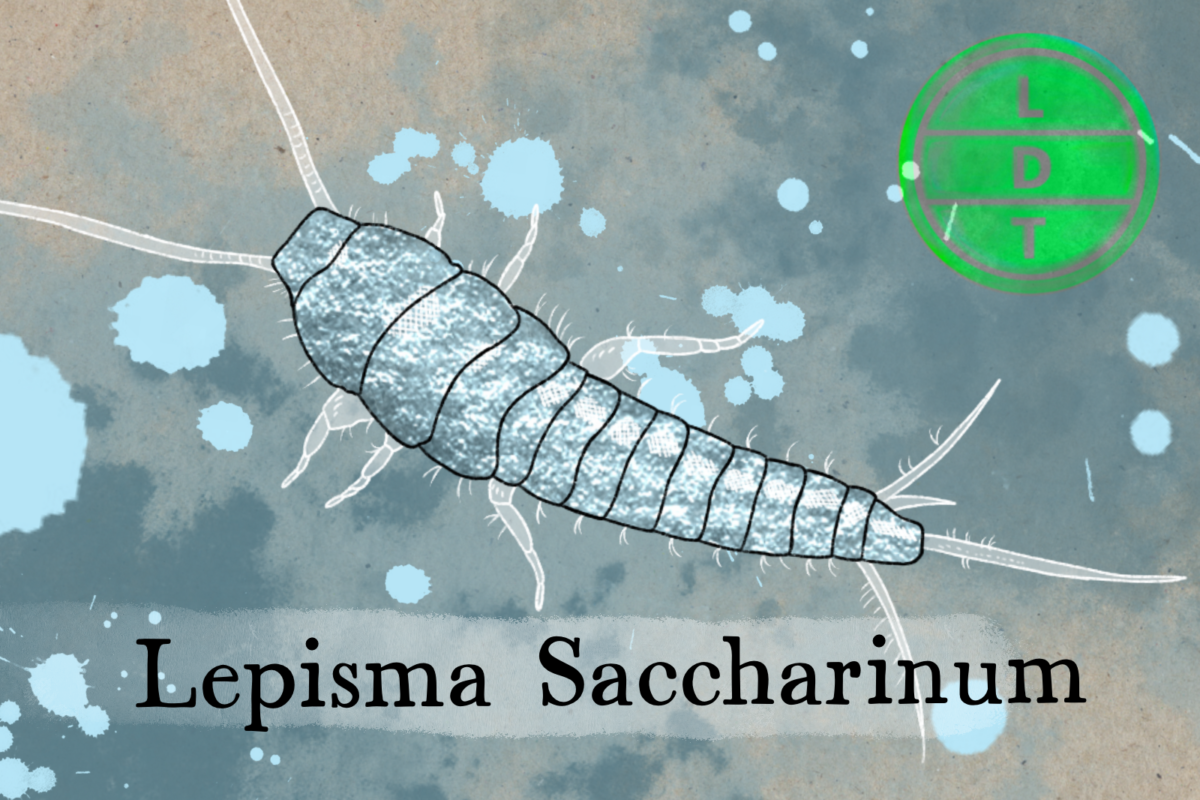“…and today we’re talking about a bookworm. Literally, but also not literally. More on that later.”
In the dark of an academy library, a shining silverfish ponders some of life’s greatest questions, like, “what is a tastier snack, the pages of War and Peace or its bindings?” A true scholar, the silverfish must test his hypothesis before making any definitive judgements. You and I don’t have the stomach for such studies, but expanding your palate is a great way to experience Life, Death, and Taxonomy.
Description
- Definitely don’t look like fish.
- They actually look like little crustaceans–like zooplankton
- They have long silver segmented bodies with six little lobster legs poking out from the top half–juveniles are white.
- They have two long antennae that jut out from their heads and three long cerci (butt antennae) that jut out from their silverbums.
- They have two small compound eyes.
Measure Up
Welcome to the beloved Measure Up segment. The official listener’s favorite part of the show! The part of the show when we present the animal’s size and dimension in relatable terms through a quiz that’s fun for the whole family. It’s also the part of the show that’s introduced by you when you send in audio of yourself saying, singing, or chittering the words Measure Up into ldtaxonomy at Gmail dot com. We don’t have a new Measure Up intro!
Length
- 13–25 mm (0.5–1.0 in)
- How many silverfish go into the longest single volume book (thickness)?
- Hint: The book is the manga One Piece, which I think is the story of a stretchy pirate that wears a gardening hat. The book is apparently impossible to read, and it’s 21,450 pages long.
- 31.5 silverfish. The book is 31.5 inches long.
Egg size
- 0.8 mm (0.031 in) ovals
- How many human eggs go into the size of a silverfish egg?
- Hint: A human female egg is tiny. Women are born with 1 million eggs and only about 300,000 remain when they reach puberty. Then only 300 to 400 will be ovulated.
- 80 human eggs. Human eggs are about 100 microns.
Fast Facts
- Range: They pretty much live everywhere, or at least everywhere that’s moist
- Behavior:
- Can live for up to three years–a long time for an insect
- It can regenerate its antennae in a few weeks if lost
Major Fact: Real Bookworms
We talked about the carpet beetle that can eat keratin, but the silverfish is another household pest with a strange addiction.
Silverfish have the ability to digest something called cellulose. Cellulose is a substance found in plant fibers. It’s what cell walls are made of, and it’s what makes raw plants more difficult to digest for many animals.
When you or I or the dog eats cellulose in the form of a vegetable, most of it gets expelled from your body like it was caught going along with one of Ron or Harry’s clever ideas.
Silverfish produce something called cellulase in their gut. Cellulase is an enzyme that can break down cellulose into simple sugars that can be fermented through digestion. Most animals don’t produce cellulase, unless they are built to eat fibrous plants, like cows.
However, the ability of a silverfish to eat cellulose means that it might be attracted to all kinds of household products that contain the substance. They also eat other polysaccharides, like starches and dextrin, which is found in adhesives. Their ability to eat these strange things may mean you will find them going after your:
- Books (Paper and book bindings)
- Carpet
- Clothes
- Coffee
- Dandruff
- Glue
- Hair
- Paint
- Family photos
- Plaster
Talk about eating you out of house and home. They particularly like wallpaper, since it’s paper that’s soaked in paste. They don’t love leather, but they will eat it if it’s all you have–and they won’t complain.
If you think you’re safe since you only use synthetic materials, they have also been known to eat synthetic fabric.
If you decide to starve them out by replacing everything with stone and other non-edible things, they will live for a full year as long as they have water.
In this fight, it turns out spiders are your ally. Spiders are common silverfish predators that also leave your goods and textiles alone. In fact, spiders make silk, so technically they leave your home with more fibers than they found.

